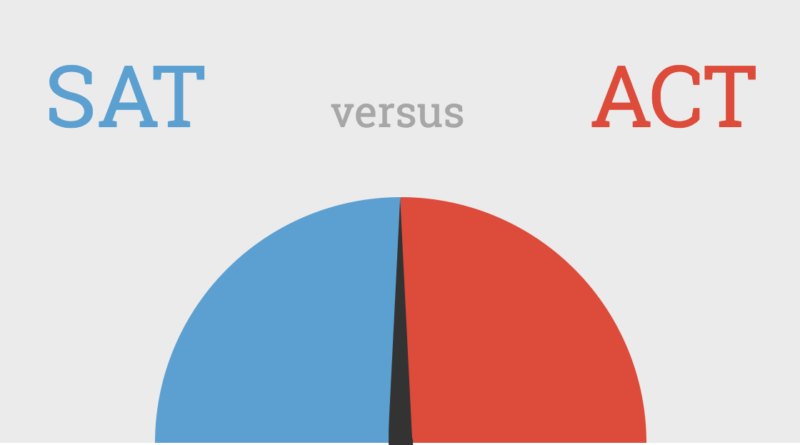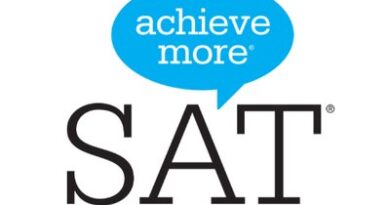SAT vs. ACT: Which One Should You Take?
Testing is a significant part of your high school experience. If you’re looking to apply to colleges, a standardized test score may be required for applications. There are two main options: the SAT and the ACT. Wondering which one is right for you? Take a look at our individual first hand SAT and ACT testing experiences for some more in depth information about each test.
SAT: Kat Comer
The SAT has been the test engraved in my mind for the longest. After taking the PSAT three times from 8th to 10th grade (all of which were administered through my schools), it only seemed right to follow up with the real version itself.
I chose to take the SAT without the essay portion, so my testing experience was a bit different from that of others who took the full version of the test.
Because of COVID-19, this year’s testing experience had some precautions introduced. Masks were required before entering the testing facility (which in my case was Paint Branch High School), and students and staff were kept at a distance from each other. A usual classroom that could fit 30 students held no more than 15 for our testing sessions. However, what didn’t change was test security: our admission tickets and our photo IDs were checked multiple times before we entered the classroom.
The SAT itself doesn’t test anything “specialized,” for example science or social studies, explicitly. It has five sections: reading, writing/language, math without calculator, math with calculator, and a randomized section of one of the latter four options. All of these sections vary in allowed duration and question amounts.
For me, the time to question ratio wasn’t too bad. I could answer all the questions in a section and still have time to go back to check the ones that I was unsure of. In my experience, the reading section had me the most pressed for time, while the math sections left me with more than enough. I would consider myself equally good at both English and math, but the reading section always tends to take more thought and consideration per answer in my experiences.
The reading section tested mainly theme, purpose, and in-text connections on a variety of types of passages. I had been given five passages with around ten questions following that corresponded to each given passage. I was given a variety of texts, including fiction and non-fiction texts, letters, and scientific analyses. These pieces also came from a variety of time frames, with some authored in the 1800s to some written in the present. I took the approach of reading each passage in its entirety before answering the questions, but there are other ways to go about it. In my opinion, one of the higher barriers of the test is the language. The older pieces do contain obsolete language that was confusing, even with the context clues that are offered. But, it was still possible to answer most of the questions without this knowledge, so don’t worry if you don’t understand every word.
The writing section gives you multiple passages and covers not only grammatical corrections (like correcting ‘its’ to ‘their’), but sentence placement, text purpose, and thought execution. For example, some of the questions asked me whether an author should include or omit a sentence, what sentence makes the best introduction to the paragraph, and where to place a sentence for the passage to make the most sense. Knowing the basics of English grammar would get you through a good portion of the questions, but knowledge on how to convey messages is also good to have. For me, the writing section was just like peer editing a friend’s English paper: just taking what they wrote and making it the best it can be.
The SAT math questions don’t cover any topics related to advanced calculus, statistics, or higher, which was great to be assured that I knew how to solve everything on the test. But, if you’ve taken your Pre-calc and prior classes a while ago, like me, make sure you refamiliarize yourself with those topics.
It may be easy to think that the non-calc questions would be extremely hard to answer without one and the with-calc questions would be even harder because you get to have a calculator, but that wasn’t the case for me. The with-calc and non-calc sections didn’t vary too much in topics covered, and I could answer a good amount of the questions in both sections pretty easily without a calculator. The SAT also provides you with a set of very useful equations at the beginning of each of the math sections. Not all of them will be used, but it is great to not have to memorize the equation for the volume of a cylinder in case you’d need it.
We had three breaks during my testing experience: one ten minute break after the reading section, a five minute break after the writing section, and a two minute break before the fifth section. During that time, we were allowed to eat a snack, get some water, or use the bathroom.
Something about the SAT is that it still highlights science and social studies skills without having a dedicated section to the topic. For example, some of my reading passages covered topics and language dealing with lab experiments or historical activities. But, don’t be scared if you aren’t a pro in science or social studies; since these topics aren’t given their own designated sections, the main focuses are still on reading and English skills.
My SAT score came out a little over two weeks after my testing date, which, although the suspense is killer, is a reasonable amount of time.
ACT: Zachary Musyimi
The ACT is a fast-paced exam that contains four sections, all with different times to be completed. Since I worked better under pressure, I thought I could do better on my ACT instead of the SAT. Here’s how that went:
There are four sections on the ACT: English, Math, Reading, and Science. All present their own respective challenges and all have to be approached in different fashions.
Unlike the SAT, the ACT includes a science section. I thought I was good at science so I decided to try it out. Thinking that the science section included science material was my first mistake. The science section is a graph interpretation section that includes some outside knowledge questions. You have 35 minutes to read 6 passages and answer 40 questions. Given that this is the last section, you should prepare to feel fatigued while completing this section. This is a very time-crunching section that leaves you no time to be stuck on a question.
When I tell my peers that the ACT English section requires you to read 5 passages and answer 75 questions in 45 minutes, they freak out. What they don’t know, however, is that it is the most straightforward section of the four. All you have to know are the fundamentals of grammar and punctuation. You answer the questions while you’re reading and over time you’ll see patterns that’ll get you the correct answer before you even turn to the answer choices. If this time restriction seems daunting, don’t be phased.
The huge advantage of taking the ACT Math section is being able to use your calculator for all the questions. You’re given 60 minutes to answer 60 questions. The easier questions tend to come first and difficult questions appear at the end. A popular approach to this section is the 20-20-20 method: Answer the first 30 questions in 20 minutes, the next 20 questions in 20 minutes: the last 10 questions in 20 minutes. The ACT also includes trigonometry and other material learned in Calculus courses. The math section is the most repetitive section out of the four. If you take enough practice tests to learn the formulas, you should be good for this section.
Now, for my personal worst section of them all, the reading section. I don’t even know where to start. This section puts all students in a time crunch. You have to learn how to skim and successfully comprehend the main idea of a passage, or else you are going to have to forfeit one of the other readings, causing you to miss out on a huge part of the test. If you’re a speed reader, this is the test for you. This section requires you to read 4 passages, which are all about 800 words each, and answer 40 multiple-choice questions in 35 minutes. There are numerous techniques on how to approach this section and it all depends on what’s best for you.
In between the math and reading section, there is a 15-minute break. This allows students to eat a nutritious snack to keep them sane for the remaining reading and science section. You may also get up and stretch, or even chat with some friends outside of the testing room. Unless you’re the student who left the science section 5 minutes early, I’d recommend you take that time to use the restroom.
Due to COVID-19, all students are required to wear masks. For verification purposes, all students had to remove their masks before sitting at their assigned seats. You are required to bring a hard copy of your school ID and the admission ticket that was printed after your registration for the exam. Each room fits about 12 students, all while maintaining social distance standards. For the most part, the testing centers follow COVID regulations, and allow your main focus to be on the test in front of you.
My testing experience was great until I saw how crowded the bathrooms were. For my information on my ACT experience, check out my article.
Conclusion:
Most schools start their students out with the PSAT; if you liked the structure of that test, and find yourself doing well after multiple times, then the SAT is the right test for you. The SAT is also a good option if you like having a bit more time per question and know how to make connections given the topic at hand. But, if you believe you work better under pressure, like the idea of having a calculator for the math section, enjoy analyzing experiments with a bit of outside knowledge, and are confident in your grammar skills, the ACT is for you. All students are different. Be sure to take full-length practice tests to determine which test is right for you. If you do better on the ACT, take the ACT and vice versa.
Regardless of what test you choose to take, taking either can be an important part of many college application processes. (But don’t freak out! Many schools are going test optional). Take the time to study, get comfortable with any topics you need, and find the best way to approach the test you plan on taking. Focus on reaching your personal best, and the result you’re looking for will follow.




